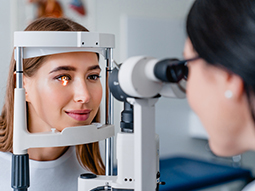What is a pterygium?
A pterygium (sometimes called “surfer’s eye”) is a benign eye growth. It is a triangular piece of pink-colored tissue that grows over the clear membrane that covers the whites of the eyes (the conjunctiva). Sometimes, a pterygium extends over the cornea. Pterygia are often painless, but in some cases, they cause discomfort or vision impairment.
If you are noticing a change to the appearance of your eyes, are experiencing vision impairment, or are suffering with eye discomfort, MedStar Health is here to help. Come consult with our expert ophthalmologists. We can help you to determine if you are developing a pterygium or another eye condition, discuss your options, and help you obtain the best possible outcomes. Our physicians can help you see a brighter future for your eye health.
Causes of pterygia
The causes of pterygia are not clear, but the condition seems to be related to prolonged exposure to UV light (for example, sunlight) and eye irritants like sand and dirt. There may also be a genetic component to pterygium risk. People who grew up in a high sun exposure area, spend a lot of time outdoors, have dry eyes, or have a family history of pterygia may be at higher risk for developing this condition.
Symptoms of pterygia
Pterygia can usually be observed with the naked eye, although they range in size and color. Some patients will experience no other symptoms. Some may experience:
- Burning or itching
- Feeling like something is stuck in the eye
- Vision impairment
Diagnosis of pterygia
Diagnostic tests for pterygia are completed in an outpatient setting. Your MedStar Health ophthalmologist will first talk with you about your symptoms and medical history. He or she will want to know about the issues you are experiencing with your eyes, as well as any medications you may be taking or medical conditions you may have. Next, he or she will conduct an eye exam. Generally, a pterygium can be diagnosed based on a microscopic examination of the eye and eyelid.
Treatment for pterygia
The symptoms of a pterygium can often be treated with medication, including artificial tears, lubricating ointments, and corticosteroid creams. These treatments can alleviate discomfort but will not remove the pterygium or stop it from spreading.
Pterygia can also be surgically removed. During this procedure, you will likely be lightly sedated while your surgeon removes the pterygium tissue with a surgical instrument. Stitches are often not needed, and you will likely need just one to two days of recovery time.
Our providers

Expert ophthalmology care
Getting the care you need starts with seeing one of our ophthalmologists.









